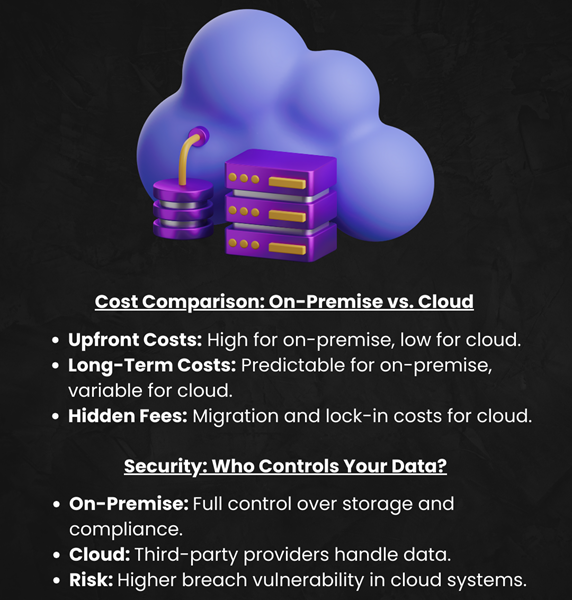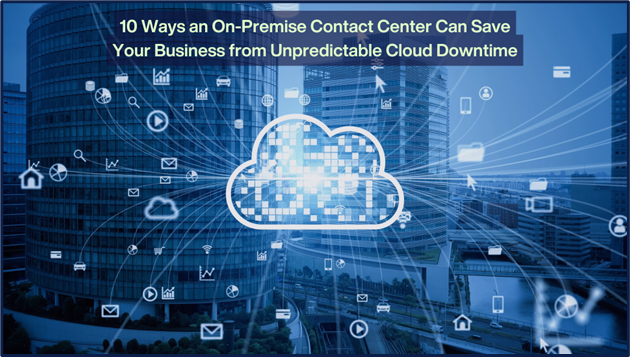How On-Premise Contact Center Prevents Cloud Downtime
In today’s fast-paced business world, customer service is more critical than ever. Many businesses have transitioned to cloud-based solutions to take advantage of scalability, flexibility, and lower upfront costs. However, despite these benefits, cloud systems come with risks—one of the most concerning being unpredictable downtime. While cloud services continue to grow, with projections showing the market will reach $675 billion by 2024, many companies are realizing that the risks associated with reliance on cloud infrastructure are too significant to ignore.
1. Seamless Control Over Your Infrastructure
Cloud solutions are increasingly popular, but they come with challenges. As organizations depend more on cloud services, they face a higher risk of outages and interruptions.
On the other hand, on-premise contact center solutions offer businesses full control over their systems, reducing downtime caused by external factors. If issues arise, businesses can resolve them internally, avoiding the delays often associated with waiting for a cloud provider’s response. This ensures that service quality remains high, even during cloud instability or unpredictable outages.
2. Better Data Supremacy and Compliance
Businesses often choose cloud solutions, which involve storing sensitive data with third-party providers that typically have robust security policies. However, for organizations bound by strict regulations like GDPR or HIPAA, storing data across multiple countries can be challenging.
With an on-premise contact center, businesses retain control over data storage, processing, and location. This control helps meet regulatory requirements, as sensitive data stays within the organization’s premises. For industries handling highly sensitive data, on-premise systems ensure compliance and reduce the complexities of relying on cloud storage.
3. Lower Risk of Cybersecurity Breaches
The cloud is an attractive location for cybercriminals because of the amount of information it holds. Even though cloud providers put in place security measures, there is no such thing as a perfect system. For example, several high-profile incidents have indicated that cloud solutions tend to be more insecure than in-house systems.
In the case of an onsite contact center, a company has more options for actively managing and implementing security strategies. By keeping everything within the organization, companies are able to ensure greater security, carry out regular assessments, and address threats more promptly as compared to external vendors. This degree of authority is critical in the aspect of quickening the response towards cyber security.
4. Minimizing Business Continuity Risks
Among the many threats posed by cloud-based contact centers, none is greater than the potential for downtime, which can result from maintenance work, security breaches, or breakdowns in systems. Such downtimes can be detrimental to business operations as well as customer experience.
A physical contact center takes away this threat by allowing companies to formulate their own business continuity tactics and disaster recovery plans. This is because such systems are not dependent on internet connectivity and the activity of cloud providers, which makes them less susceptible to crises. For instance, businesses can also resort to backup systems and failover switching to reduce the length of service interruption.
5. Increased Reliability with No Dependency on Internet Connectivity
For a cloud contact center to effectively perform its primary function, it is important to have a strong and stable internet connection. More often than not, any disruption in communication would cause confusing situations and delays in service delivery resulting in customer dissatisfaction. On the contrary, on-premise contact centers do not rely on internet systems to function meaning their operations can go on without any interruption in areas with poor internet connectivity.
In places with unreliable or intermittent access to the internet, on-premise systems are often more reliable as they ensure customer service agents can attend to customers without any break in service.
6. Immediate Troubleshooting and Technical Support
Most cloud contact centers depend heavily upon the technical support offered by the provider, which may result in floating issues. Delays are inevitable as you are confined to their back office teams.
In contrast, with on-premises contact center solutions, the end-user is immediately attended to by the in-house IT team making it easy to fix any challenges present. This guarantees instant fixing of problems and therefore a reduction in the downtime one experiences before services are restored. Therefore, it is very important to have direct support when every second of downtime is critical.
7. No Vendor Lock-In
Most cloud service providers work under inconvenient and expensive subscription models that are hard to modify. Vendor lock-in happens when companies remain with a certain supplier because of its unique technology, the high price of changing providers, or unfavorable contract conditions, which restricts operational flexibility.
On-premise contact centers allow this problem to be avoided by enabling companies to undertake any hardware, software, and providers without worrying about compliance risks or committing for a long time. This gives greater freedom and control as corporations are able to update or change service providers without having to endure expensive and unfair contracts.
8. Customization and Flexibility for Specialized Needs
Most of the cloud computing solutions offered are for general use, which may not be the case for all services. Some organizations have to use specific configurations, particular processes, or interfaces with licensed applications.
Compared to this, on-premise contact centers offer more customization and adaptability. These systems can be adjusted to meet particular requirements so that companies can deploy the technologies that suit them best. This flexibility enables organizations to remain competitive by transforming their customer support processes to meet the changing customer needs.
9. Cost Control and Predictable Expenses
Let us analyze the pros and cons of both if possible:
Usage-based computing has its advantages as much as it imposes a lot of limits on the companies and therefore cheap solutions are often preferred by corporations.
In on-premise contact centers capital expenses – on hardware and software – have to be incurred before any revenues. However, these costs are easier to estimate over time. When the system has been set up, there tend to be lower recurring costs – on maintenance – and fewer shocks in terms of pricing. The ability to forecast such occurrences is an advantage when it comes to establishing a firm’s budget and future expectations.
10. Enhanced Customer Experience with Localized Support
An on-premise contact center facilitates the training and gearing of the customer support teams as per the expectations of the business. This enables the businesses to provide a well-tailored service and thus increase customer satisfaction.
Support teams established in geographical proximity to the client will possess adequate product or service knowledge, making them able to address intricate problems, hence ensuring the effectiveness of customer engagement satisfaction. This is difficult to achieve in the case of cloud solutions especially when services are outsourced and organizations are not allowed to monitor their customer care services.
Comparison: On-Premise vs Cloud Contact Center

| Feature | On-Premise Contact Center | Cloud Contact Center |
| Control Over Infrastructure | Full control and management | Dependent on third-party cloud service provider |
| Data Security | Complete control over data storage and access | Relies on the cloud provider’s security protocols |
| Customization | Highly customizable based on specific needs | Limited customization based on the provider’s offerings |
| Business Continuity | Custom disaster recovery solutions | Dependent on the cloud provider’s uptime and backups |
| Cost | Higher initial costs, stable long-term costs | Variable costs, based on usage |
| Reliability | Not affected by internet outages | Can be affected by internet connectivity or cloud outages |
| Technical Support | Immediate, in-house support | Dependent on third-party support |
Making the Right Choice for Your Business
The decision about whether to opt for an on-premise or a cloud-based contact center affects the quality of customer service. The cloud is characterized by easy integration and scalability while on-premise systems offer more reliability, security, and control, especially in instances where there are problems with accessing cloud resources.
However, taking into account the business requirements, norms, and risks helps to evaluate the most appropriate solution for the contact center to achieve the objectives of the organization.
FAQs
- What is the main advantage of an on-premise contact center over a cloud-based one?
The main advantage is control—on-premise contact centers allow businesses to manage their infrastructure directly, ensuring uninterrupted service and avoiding the risks of cloud downtime. - How does an on-premise contact center improve data security?
On-premise contact centers keep data stored within the company’s infrastructure, allowing for more rigorous control over security measures and ensuring compliance with data regulations like GDPR and HIPAA. - Are on-premise contact centers more expensive than cloud solutions?
While on-premise systems involve higher initial setup costs, they offer predictable long-term costs. Cloud solutions, by contrast, often come with fluctuating subscription fees, which can become more expensive.




